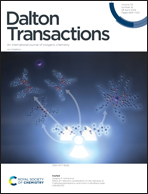Influence of the phonon-bottleneck effect and low-energy vibrational modes on the slow spin-phonon relaxation in Kramers-ions-based Cu(ii) and Co(ii) complexes with 4-amino-3,5-bis-(pyridin-2-yl)-1,2,4-triazole and dicyanamide†
Abstract
Two new complexes, bis-[4-amino-3,5-bis-(pyridin-2-yl)-1,2,4-triazole-κ2N2,N6]bis-(dicyanamide-κN8)copper(II), [Cu(abpt)2(dca)2] (1) and bis-[4-amino-3,5-bis-(pyridin-2-yl)-1,2,4-triazole-κ2N2,N6]bis-(dicyanamide-κN8)cobalt(II), [Co(abpt)2(dca)2] (2), have been prepared and magneto-structurally characterised. Single crystal studies of both complexes have shown that their crystal structures are molecular, in which the central atoms are six-coordinated in the form of a distorted octahedron by two bidentate abpt and two monodentate dca ligands. Even if both complexes have the same composition and crystallize in the same P![[1 with combining macron]](https://www.rsc.org/images/entities/char_0031_0304.gif) space group, they are not isostructural. Both structures contain strong intermolecular N–H⋯N hydrogen bonds and π–π stacking interactions. IR spectra are consistent with the solved structures of both complexes and confirmed the terminal character of the dca ligands and the bidentate coordination of the abpt ligands. The analysis of the magnetic properties showed that both complexes exhibit field-induced slow spin-phonon relaxation. In both complexes, the slow spin-phonon relaxation is influenced by a severe phonon-bottleneck effect that affects the direct process, a dominant relaxation mechanism at low temperatures in both complexes. The phonon-bottleneck effect in 1 was suppressed by simply reducing the crystallite size, and further analysis of the field dependence of the relaxation time yielded the characteristic energy of vibrational modes of 11 cm−1 participating in the Raman process at low magnetic fields. The analysis of magnetic properties and ab initio calculations confirmed that 2 represents a system with a moderate uniaxial anisotropy yielding an average energy barrier of 82 cm−1 (from all four nonequivalent Co(II) sites in the structure of 2).
space group, they are not isostructural. Both structures contain strong intermolecular N–H⋯N hydrogen bonds and π–π stacking interactions. IR spectra are consistent with the solved structures of both complexes and confirmed the terminal character of the dca ligands and the bidentate coordination of the abpt ligands. The analysis of the magnetic properties showed that both complexes exhibit field-induced slow spin-phonon relaxation. In both complexes, the slow spin-phonon relaxation is influenced by a severe phonon-bottleneck effect that affects the direct process, a dominant relaxation mechanism at low temperatures in both complexes. The phonon-bottleneck effect in 1 was suppressed by simply reducing the crystallite size, and further analysis of the field dependence of the relaxation time yielded the characteristic energy of vibrational modes of 11 cm−1 participating in the Raman process at low magnetic fields. The analysis of magnetic properties and ab initio calculations confirmed that 2 represents a system with a moderate uniaxial anisotropy yielding an average energy barrier of 82 cm−1 (from all four nonequivalent Co(II) sites in the structure of 2).

- This article is part of the themed collection: Dalton Transactions HOT Articles


 Please wait while we load your content...
Please wait while we load your content...